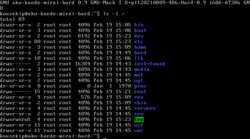
GNU is an extensive collection of free software, which can be used as an operating system or can be used in parts with other operating systems. The use of the completed GNU tools led to the family of operating systems popularly known as Linux. Most of GNU is licensed under the GNU Project's own General Public License (GPL).

In computer science, a microkernel is the near-minimum amount of software that can provide the mechanisms needed to implement an operating system (OS). These mechanisms include low-level address space management, thread management, and inter-process communication (IPC).
Mach is a kernel developed at Carnegie Mellon University by Richard Rashid and Avie Tevanian to support operating system research, primarily distributed and parallel computing. Mach is often considered one of the earliest examples of a microkernel. However, not all versions of Mach are microkernels. Mach's derivatives are the basis of the operating system kernel in GNU Hurd and of Apple's XNU kernel used in macOS, iOS, iPadOS, tvOS, and watchOS.
Darwin is the core Unix operating system of macOS, iOS, watchOS, tvOS, iPadOS, visionOS, and bridgeOS. It previously existed as an independent open-source operating system, first released by Apple Inc. in 2000. It is composed of code derived from NeXTSTEP, FreeBSD, other BSD operating systems, Mach, and other free software projects' code, as well as code developed by Apple.
GNU Mach is an implementation of the Mach microkernel. It is the default microkernel in the GNU Hurd. GNU Mach runs on IA-32 machines. GNU Mach is maintained by developers on the GNU project. It is distributed under the terms of the GNU General Public License (GPL).
L4 is a family of second-generation microkernels, used to implement a variety of types of operating systems (OS), though mostly for Unix-like, Portable Operating System Interface (POSIX) compliant types.

The GNU Project is a free software, mass collaboration project announced by Richard Stallman on September 27, 1983. Its goal is to give computer users freedom and control in their use of their computers and computing devices by collaboratively developing and publishing software that gives everyone the rights to freely run the software, copy and distribute it, study it, and modify it. GNU software grants these rights in its license.

Within the free software and the open-source software communities there is controversy over whether to refer to computer operating systems that use a combination of GNU software and the Linux kernel as "GNU/Linux" or "Linux" systems.
MkLinux is an open-source software computer operating system begun by the Open Software Foundation Research Institute and Apple Computer in February 1996, to port Linux to the PowerPC platform, and Macintosh computers. The name refers to the Linux kernel being adapted to run as a server hosted on the Mach microkernel, version 3.0.
Filesystem in Userspace (FUSE) is a software interface for Unix and Unix-like computer operating systems that lets non-privileged users create their own file systems without editing kernel code. This is achieved by running file system code in user space while the FUSE module provides only a bridge to the actual kernel interfaces.
TRIX is a network-oriented research operating system developed in the late 1970s at MIT's Laboratory for Computer Science (LCS) by Professor Steve Ward and his research group. It ran on the NuMachine and had remote procedure call functionality built into its kernel, but was otherwise a Version 7 Unix workalike.

Linux is a family of open-source Unix-like operating systems based on the Linux kernel, an operating system kernel first released on September 17, 1991, by Linus Torvalds. Linux is typically packaged as a Linux distribution (distro), which includes the kernel and supporting system software and libraries, many of which are provided by the GNU Project. Many Linux distributions use the word "Linux" in their name, but the Free Software Foundation uses and recommends the name "GNU/Linux" to emphasize the use and importance of GNU software in many distributions, causing some controversy.
GNU variants are operating systems based upon the GNU operating system. According to the GNU project and others, these also include most operating systems using the Linux kernel and a few others using BSD-based kernels.
Linux began in 1991 as a personal project by Finnish student Linus Torvalds to create a new free operating system kernel. The resulting Linux kernel has been marked by constant growth throughout its history. Since the initial release of its source code in 1991, it has grown from a small number of C files under a license prohibiting commercial distribution to the 4.15 version in 2018 with more than 23.3 million lines of source code, not counting comments, under the GNU General Public License v2 with a syscall exception meaning anything that uses the kernel via system calls are not subject to the GNU GPL.

The kernel is a computer program at the core of a computer's operating system and generally has complete control over everything in the system. The kernel is also responsible for preventing and mitigating conflicts between different processes. It is the portion of the operating system code that is always resident in memory and facilitates interactions between hardware and software components. A full kernel controls all hardware resources via device drivers, arbitrates conflicts between processes concerning such resources, and optimizes the utilization of common resources e.g. CPU & cache usage, file systems, and network sockets. On most systems, the kernel is one of the first programs loaded on startup. It handles the rest of startup as well as memory, peripherals, and input/output (I/O) requests from software, translating them into data-processing instructions for the central processing unit.

According to the Free Software Foundation Latin America, Linux-libre is a modified version of the Linux kernel that contains no binary blobs, obfuscated code, or code released under proprietary licenses. In the Linux kernel, they are mostly used for proprietary firmware images. While generally redistributable, binary blobs do not give the user the freedom to audit, modify, or, consequently, redistribute their modified versions. The GNU Project keeps Linux-libre in synchronization with the mainline Linux kernel.

GNU Guix is a functional cross-platform package manager and a tool to instantiate and manage Unix-like operating systems, based on the Nix package manager. Configuration and package recipes are written in Guile Scheme. GNU Guix is the default package manager of the GNU Guix System distribution.

The NetBSD rump kernel is the first implementation of the "anykernel" concept where drivers either can be compiled into or run in the monolithic kernel or in user space on top of a light-weight kernel. The NetBSD drivers can be used on top of the rump kernel on a wide range of POSIX operating systems, such as the Hurd, Linux, NetBSD, DragonFly BSD, Solaris kernels and even Cygwin, along with the file system utilities built with the rump libraries. The rump kernels can also run without POSIX directly on top of the Xen hypervisor, an L4 microkernel using the Genode OS Framework or even on "OS-less" bare metal.

Genode is a free and open-source software operating system (OS) framework consisting of a microkernel abstraction layer and a set of user space components. The framework is notable as one of the few open-source operating systems not derived from a proprietary OS, such as Unix. The characteristic design philosophy is that a small trusted computing base is of primary concern in a security-oriented OS.

GNU Guix System or Guix System is a rolling release, free and open source Linux distribution built around the GNU Guix package manager. It enables a declarative operating system configuration and allows system upgrades which the user can rollback. It uses the GNU Shepherd init system and the Linux-libre kernel, with support of the GNU Hurd kernel under development. On February 3, 2015, the Free Software Foundation added the distribution to its list of endorsed free Linux distributions. The Guix package manager and the Guix System drew inspiration from and were based on the Nix package manager and NixOS respectively.













